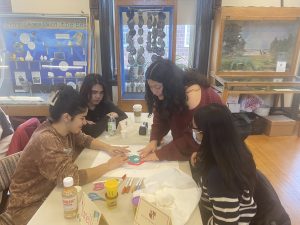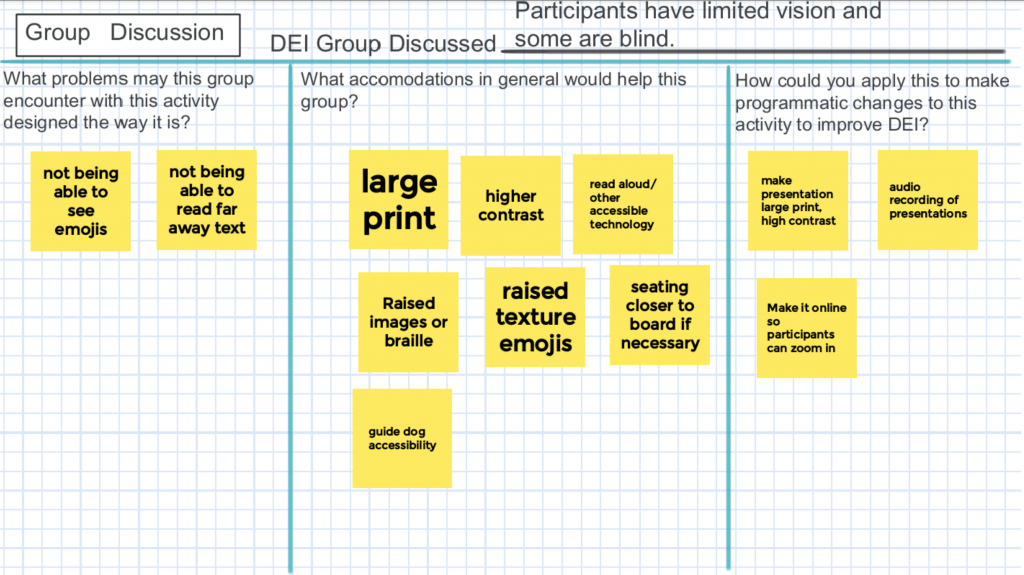SciComm for Diverse Audiences
Hands-on Science Activity
Students participated in an activity designed to model the process and teach the principles behind geologic coring. The materials used for this activity are provided in the links below, however, any interactive lesson plan can be used in its place.
- Introduction to Geologic Coring Presentation Slides

- Ask a Geologist: Introduction Geologic Coring Youtube video- Presented by Dr. Lauren Neitzke Adamo
- Emoji Core Lesson Plan
- Life Cores Lesson Plan
- Getting Wet & Muddy: Going to Sea to Core for Climate Youtube video- Presented by Dr. Liz Sikes
- Ask a Geologist: Live at Sea! Youtube video- Present by Dr. Lauren Neitzke Adamo
Reflecting on Accommodations and Accessibility
After the completion of the activity, students were tasked with discussing how the activity they just completed may be accessible to 8 different groups of individuals. They were then asked to work together in their groups to make suggestions on what accommodation or modifications could be made to the activity to make it more inclusive.
Below is a sampling of the ideas and accommodations the student groups developed.

Student Reflections
Students were asked to reflect on the question “How can I use what I learned to make Science Communication Better?” Read some of their responses below.
“We can make science communication more accommodating by using a wide range of media to communicate the same concepts. For example, having visuals, audio, interactive methods of communication. This also benefits the general public because the multiple formats reinforce the concept as they can understand it multidimensionally.”
“Based on the activity we did in class, a major theme I saw while coming up with solutions based on barriers groups with disabilities faced was addressing individuals’ needs and having someone who is educated and trained in accommodations present. In terms of science communication it is important to make information accessible by offering it in different formats such as audio, clear simple visuals, subtitles, and in different languages. It is important to ask people what their needs are and not just make content based on just what you want.”
“Realizing that everyone has different needs and keeping your audience in mind when writing about your science topic. Also, relying on multiple modes of communication to make the topic more accessible (eg. writing, visuals/art, audio, and a tactile activity).”
“I enjoyed learning how different geological features could aid with dating or approximating the dates of events/organisms. The activity we did with emojis was great because it could be used for many age groups to demonstrate the usefulness of taking a core. However, I had not considered all the different things that may limit its effectiveness, and I think doing so will make it better for everyone.”
“There are multiple ways we can act on to accommodate scientific communication better such as having subtitles on all videos, audios, repeating instructions thoroughly, having accessibility for educational institutions (school, museum), and always asking for suggestions for improvement and observing if there’s somebody in need.”
“What I learned today can enhance my skills in science communication, particularly in regards to communicating scientific concepts to people who may have disabilities which hinder the effectiveness of non-inclusive traditional methods of instruction and interaction with people outside of the scientific community and academia.”
“As we’ve been learning through the weeks, scientists embody a diverse population. Thus, when communicating with the science community, we are communicating with a multitude of people with not only different strengths and interests, but also different needs and abilities. To improve communication, we can maintain clarity of ideas and use technology that helps the greatest number of people.”
“It is important to remember that the goal of communication is to have the audience/students learn and understand. So education must incorporate techniques that best allow the audience to learn. Therefore, I could make science communication better if I research ways to make lessons accessible to the whole audience. There are many methods that have been created but are not widely used, but I can also always find new ways to teach and learn.”
“I can use what I learned to create change in institutions for a more diverse and equitable environment. For example, I could help rally to create awareness about ADHD accommodations for Rutgers classes. This would lead to more people learning about the importance of science communication and shed light on effective communication overall.”
“I found it interesting that a lot of accommodations make life easier for everyone but can also be detrimental to certain kinds of disabilities. For example, extra words on slides could be helpful for those hard of hearing and distracting for someone with a learning disability. Implementing appropriate solutions still requires a lot of discussion.”
“This lesson taught me about how to make more inclusive science education. I hadn’t really considered this previously. I normally design my activities with my level of understanding in mind. In the future, I will definitely be more aware of different people’s needs and educational levels. Furthermore, I will also design lessons that are fascinating, while also being inclusive. The capacity to develop more inclusive materials would be amazing.”
“Through active discussion and brainstorming with individuals on how to better improve lesson plans to be more inclusive, we can work to make communication more effective.”
“This lesson taught me about how to make an environment more inclusive. You don’t think about those who may not have the same functions come easy to them, so it is important to think about.”
“Always keep in mind that people learn differently. Trying to use a “one size fits all” approach is ultimately ineffective. Instead, we should be exploring all possible means of communication/teaching, so that we can reach a wider and more diverse audience.”
“This lesson taught me how to consider the needs of people who may not be able to learn in the same ways I do.”